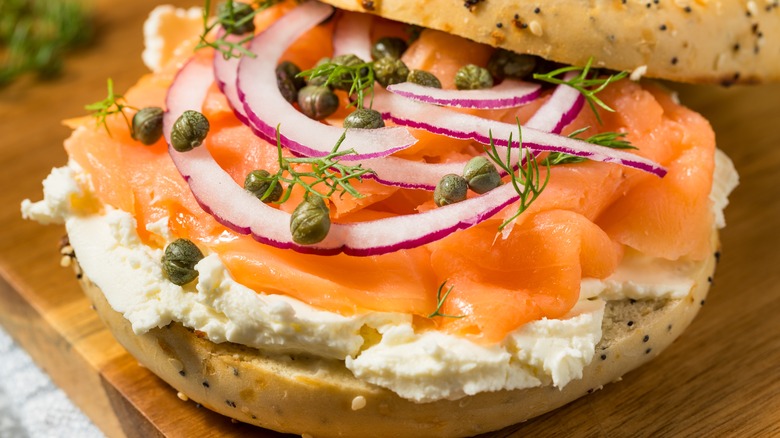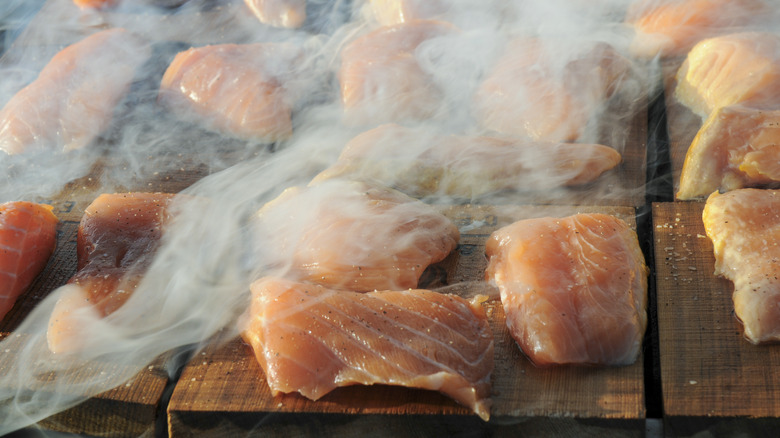Here's The Difference Between Lox And Smoked Salmon
It's been said that everyone has a doppelgänger — or twin — in the world. The same could be said for certain foods. For example, peeled bananas and plantains look identical. Cilantro and parsley could easily be mistaken for each other (visually, at least), as could soybeans and chickpeas, jam and jelly, and peaches and nectarines, to an extent. Perhaps the toughest to decipher is lox and smoked salmon, specifically cold smoked salmon.
Like smoked salmon, lox is salmon that's been cured in salt (and sometimes other seasonings) and is typically sliced paper-thin. You can use both for bagels with cream cheese, scrambled eggs, sushi, our recipe for lox rangoon (don't let the name fool you), and many more dishes. But while lox comes from the salmon's belly and is never smoked, smoked salmon can come from any part of the fish and gets its unique flavor from smoking. Smoked salmon also comes in both cold smoked and hot smoked varieties, further differentiating it from lox.
All about lox
To make lox, salmon is packed in salt for curing. It can also be cured in a salt brine, but it is never cooked in the traditional sense (as in, over a heat source). The salt draws out the moisture of the fish, which discourages bacterial growth, making it more shelf-stable and completely edible. The result is a shiny, salty chunk of fish that is sliced paper thin for serving. Lox is rich, buttery, and maintains a nice salmon flavor, but is also very salty. Because a little goes a long way, thin or small pieces of lox are often used on canapes, and you certainly don't need a pile of it on your bagel and cream cheese for it to be delicious. You can also try lox on an English muffin instead.
Lox is often associated with Jewish cuisine and delis. In fact, the word "lox" itself is Yiddish, derived from the word "laks" which means "salmon." In Jewish Kosher eating laws, fish like salmon is fairly unrestricted and was not difficult to come by when Eastern European Jews immigrated to America. But the concept of salt-curing or brining salmon for preservation is actually Scandinavian in origin.
All about smoked salmon
While there are two types of smoked salmon (and here is how long smoked salmon will stay good once opened), cold smoked salmon is the type often mistaken for lox. Cold smoked salmon begins just the way traditional lox does: It is first brined to draw the moisture out and preserve the fish. Then the salmon goes through a period of smoking, not to cook the meat, but to impart flavor. It's smoked at a temperature no higher than 85 degrees Fahrenheit, and once it's done, the texture is as smooth as that of lox. Sliced just like lox, it's easy to see why the two are so often mistaken for each other.
On the other hand, salmon can be hot smoked as well. With this method, raw sides or filets of salmon are smoked at 145 degrees Fahrenheit. It's very much like smoking ribs or brisket because the heat of the smoke from wood chips or pellets cooks the protein. The result is a much firmer and flakier fish with a wonderful smoky flavor perfect for pasta dishes, dips, and spreads.
While hot smoked salmon is popular in Scandinavian countries, it also has ties to Native American tribes in the Pacific Northwest where salmon is a prevalent food source. A longer smoking period (up to two weeks) makes the fish resemble jerky and last much longer than cold smoked or modern hot smoked salmon, though it would hardly ever be mistaken for lox.


